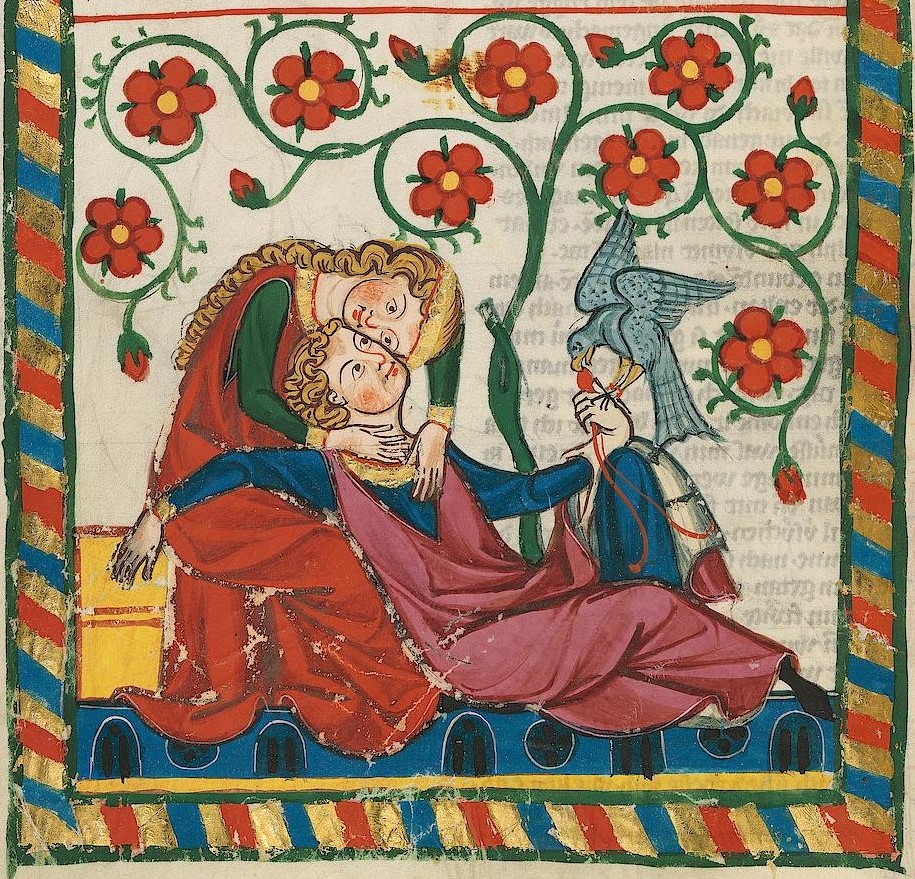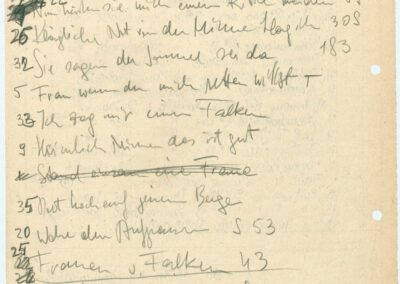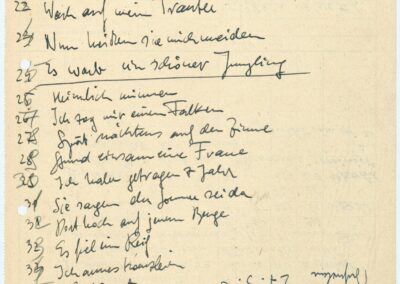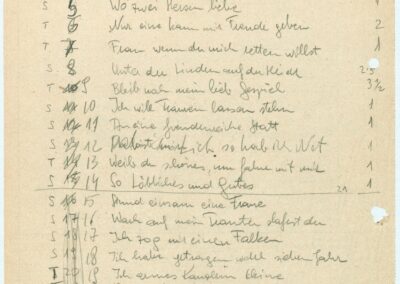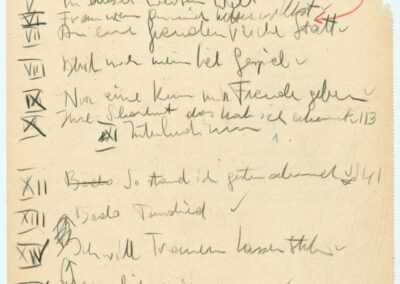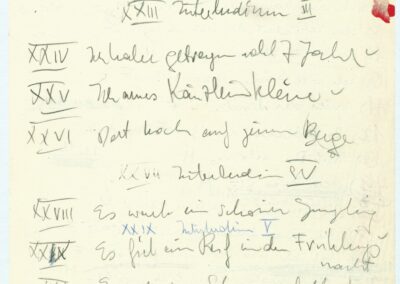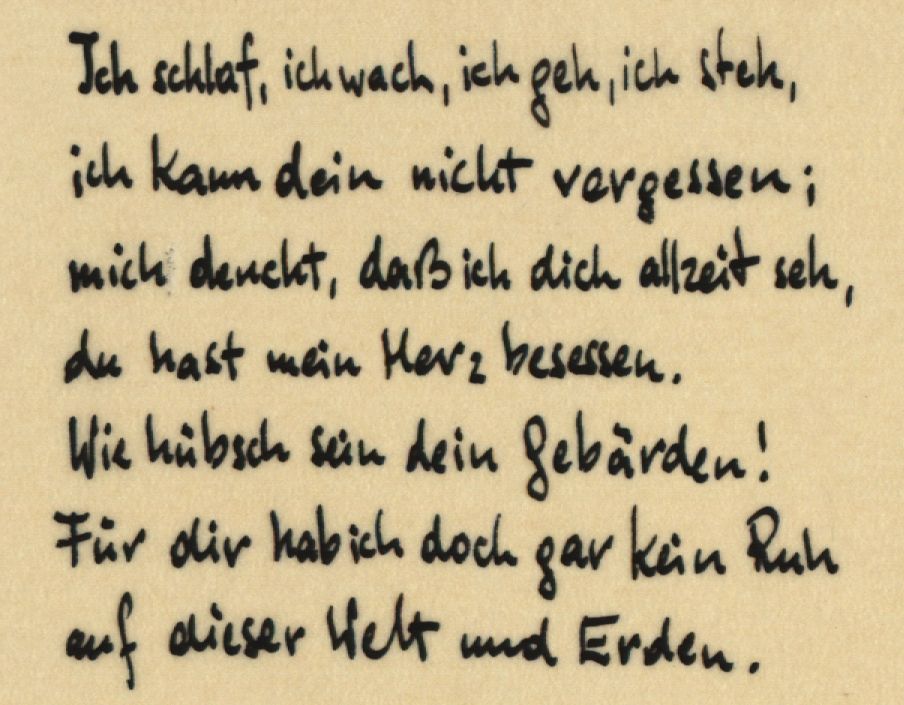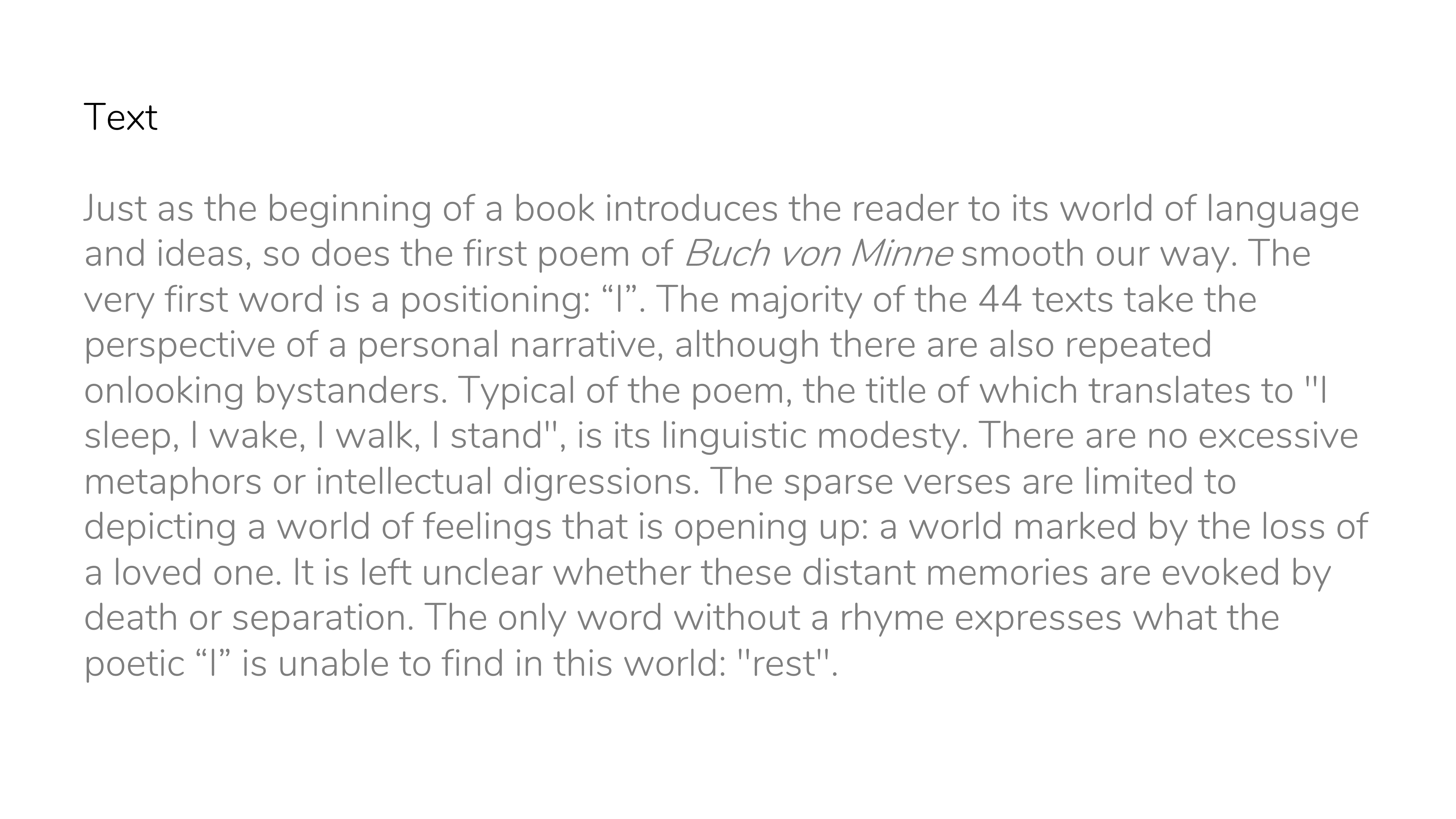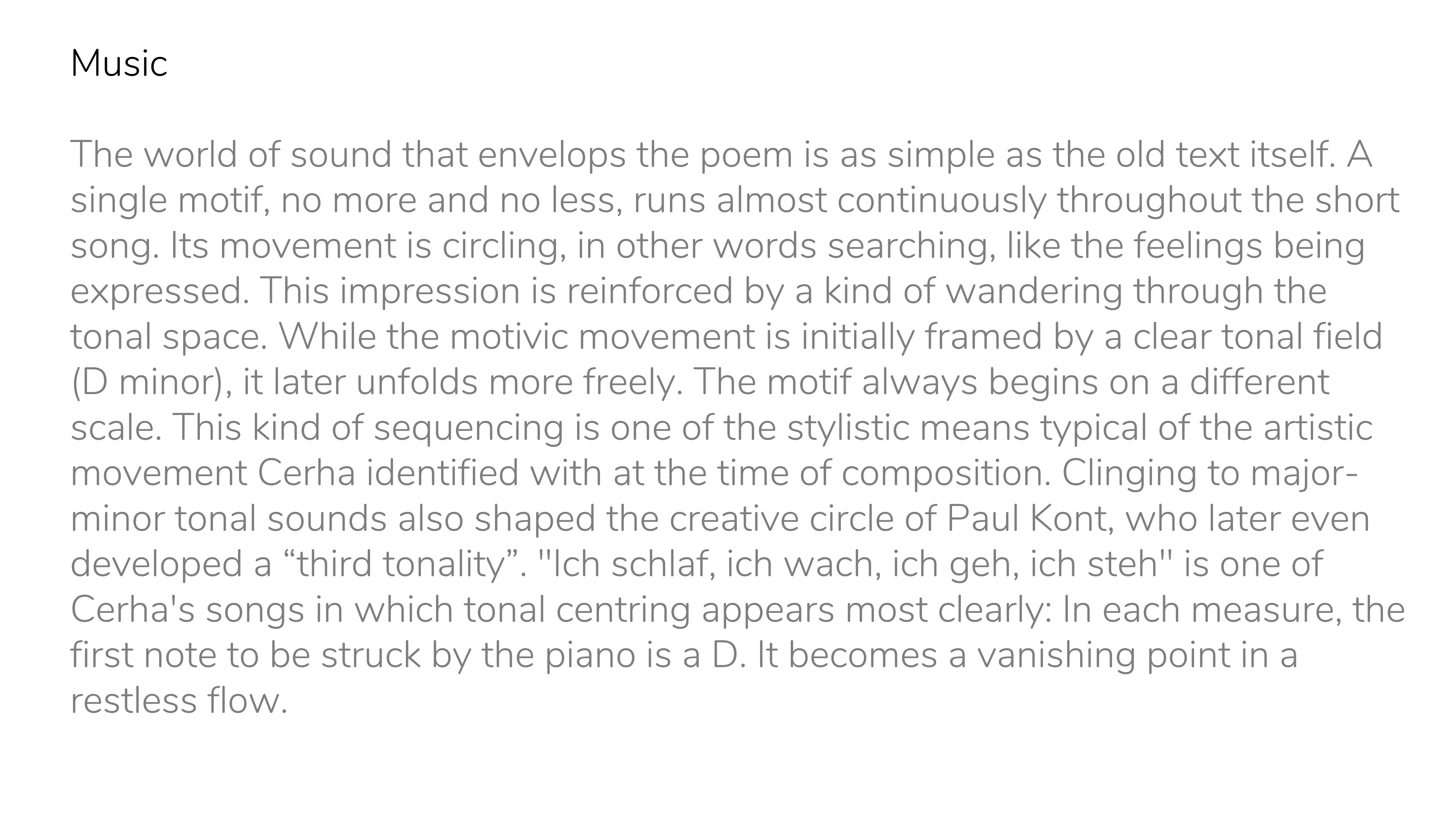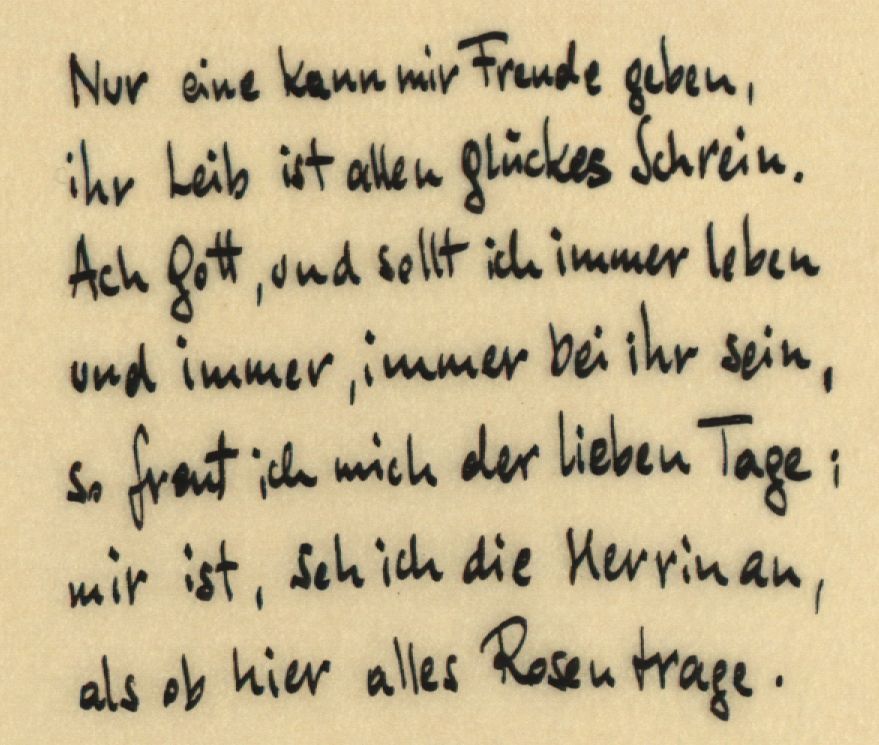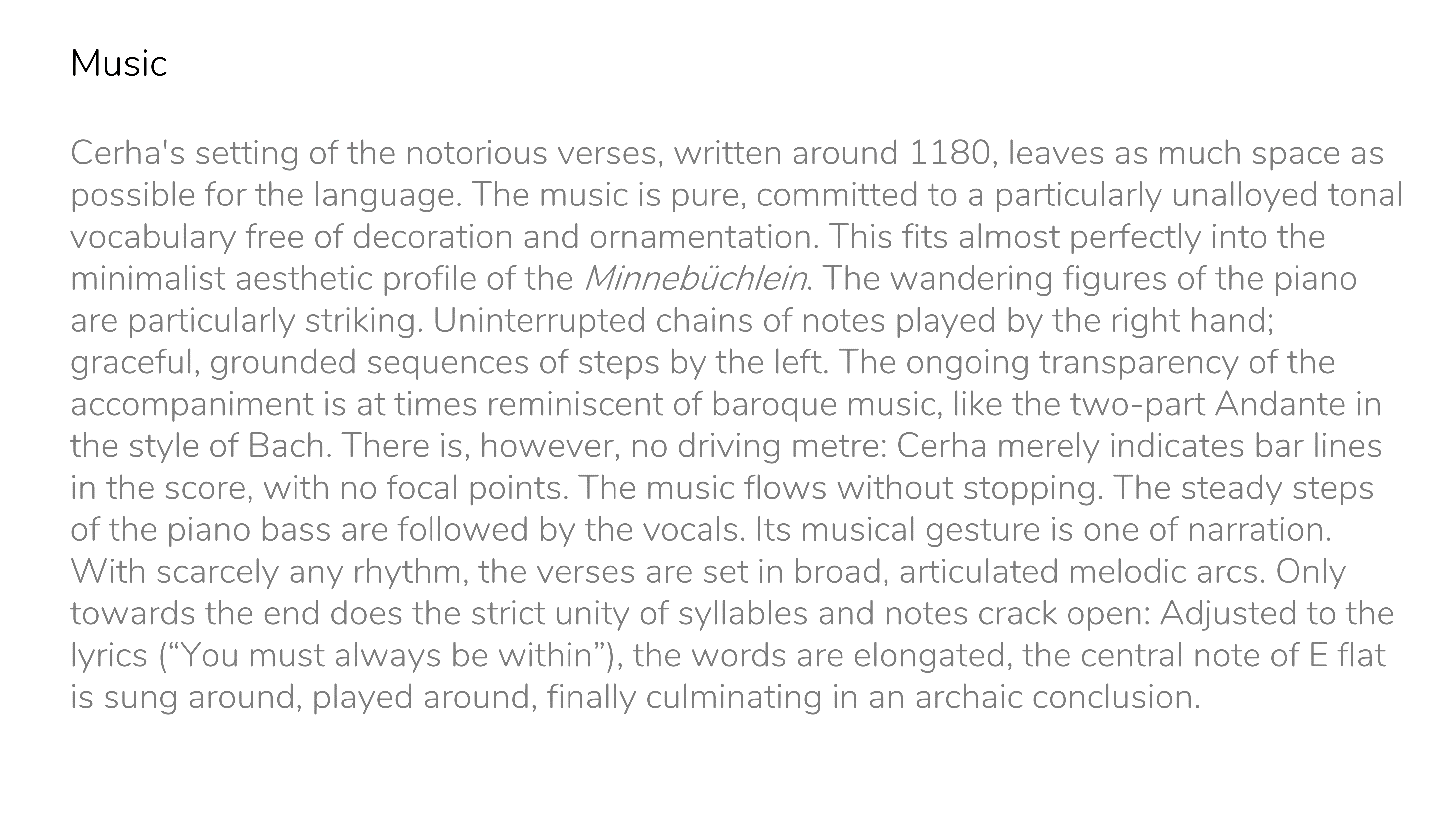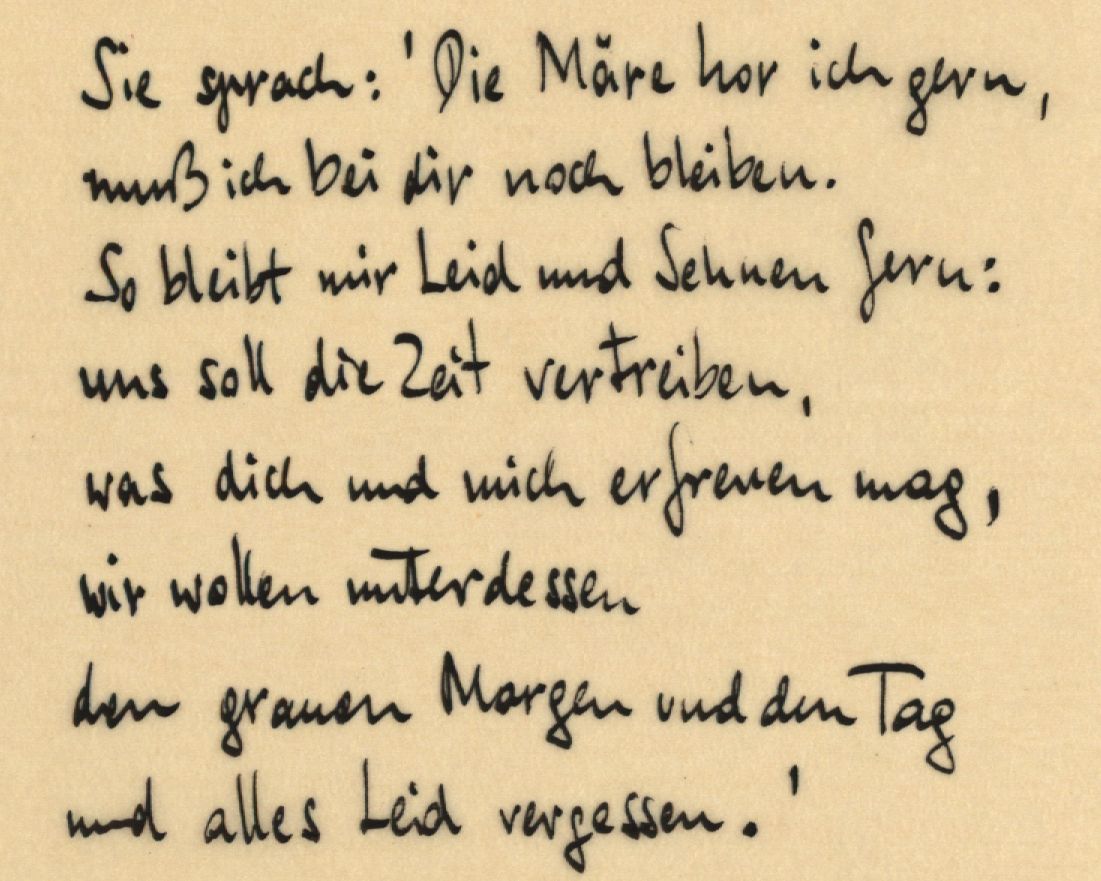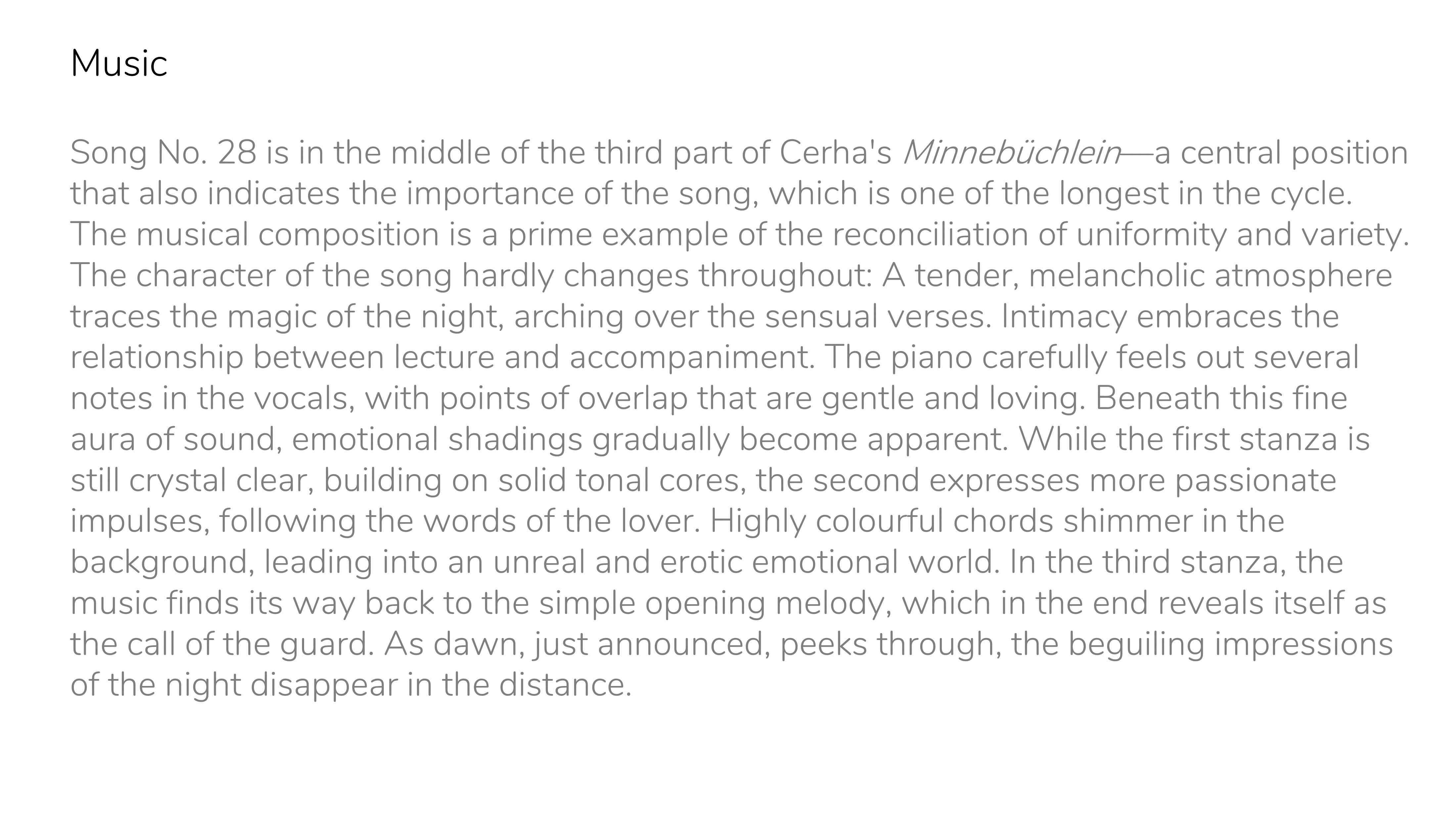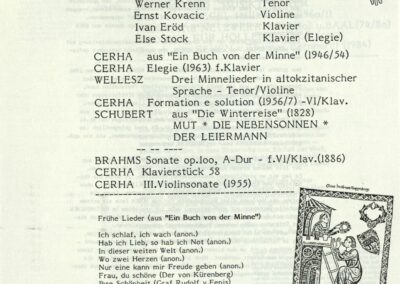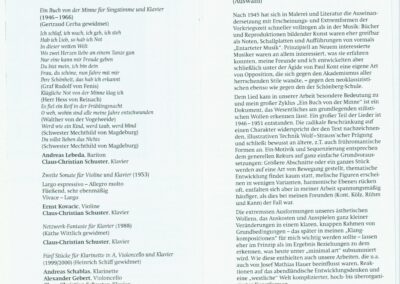Ein Buch von der Minne
Dû bist mîn, ich bin dîn…
Konzert für Schlagzeug und Orchester
Monumentum
Portrait of Walther von der Vogelweide
Mural, Berwartstein Castle, Rhineland-Palatinate, Germany
The writings of Walther von der Vogelweide were among the central achievements of medieval poetry. A painting from the Codex Manesse (a manuscript from around 1305 to 1315) shows the poet seated on a large stone, an empty scroll in his hand. This depiction of him became widely known, evolving over the years in many different ways—seen here with a variation of the anonymous verse “Dû bist mîn, ich bin dîn” (You are mine, I am thine) on the scroll, which also shows up in Cerha’s Buch von der Minne.
Source: H.Zell/Wikimedia
Highly educated in literature, Cerha has a special interest in the poetry of the Middle Ages, as evidenced by a volume on the topic in his private library.
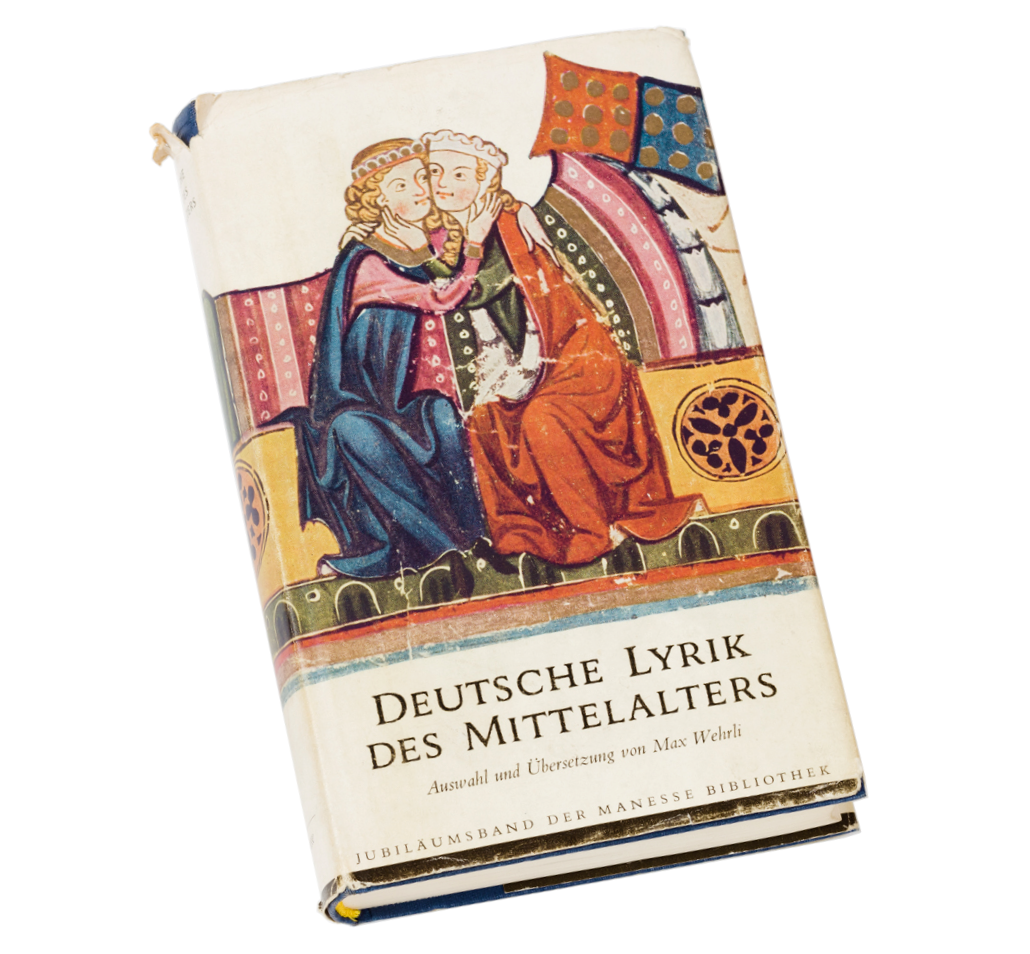
Max Wehrli, Deutsche Lyrik des Mittelalters, Zurich 1955, Cerha's private copy
Photo: Christoph Fuchs
Swiss literary historian Max Wehrli dedicated himself to the pre-modern history of German-language literature. A book of poems he edited is part of the Manesse Library of World Literature—Manesse referring to the Codex Manesse, the most extensive surviving manuscript of medieval songs. In the fourteenth century, the writings of numerous authors were recorded on 426 sheets of parchment, thus ensuring the survival of this poetry to the present day. Cerha was enthusiastic about the “Codex” poems from an early age. His curiosity was not only literary but also musical in nature. For example, he rearranged the song cycle Ein Buch von der Minne to create an entirely new piece, setting it to music. He dedicated the piece to his true love, Gertraud Cerha.
Außenansicht
After the interruption of the war, this trend continued, though in a different direction. While many of Cerha’s early songs were still influenced by tradition and emulated the opulent style of late Romanticism, the composer was now interested in simplicity. Less was more, and others were also composing along these lines, for example Gerhard Rühm, Ernst Kölz, and Paul Kont. The latter in particular became a “kind of father figure” for Cerha, although he was “only six years older”.Schriften: ein Netzwerk, Vienna 2001, p. 28 His “minimalist approach of basing a piece on a movement, on a motif” soon became a model for the entire group. Their reductive ideas ripened in the underground, never penetrating the “surface” of Vienna’s major cultural venues. Instead, the progressive musicians met in the haunts of the Art Club, gathering with painters and writers:
In the other art genres, the confrontation with the manifestations of and sometimes extreme forms of pre-war art had taken place much earlier than in the field of music. Musicians who were principally interested in new things were fascinated by this and, under the aegis of Kont, developed their own kind of opposition, which consciously turned against the prevailing academic styles. Their tendencies contrasted with the aesthetics and the motivic working methods of the Romantic period, the Schönberg school, the descendants of the fin de siècle, and also the “Mathis circles” of the Hindemithians springing up at the time. Songs held special meaning in our work, and my large cycle Ein Buch von der Minne (1946–1964) is a document that provides essential evidence of the underlying stylistic drive.
Friedrich Cerha
Schriften: ein Netzwerk, Vienna 2001, pp. 218 f.
The first songs of Ein Buch von der Minne were written only a year after the end of the war, and the final ones in 1966, 20 years later. Despite this long period, during which Cerha grew as a composer in numerous ways, the cycle emerged as a homogeneous whole, primarily reflecting the trends of Vienna’s post-war era, trends which were often hidden at the time and today have been nearly forgotten.
Brücke
Surprisingly, the first inspiration in this field came from his music studies. In the summer semester of 1944 (his first year), Cerha took a class titled “Minstrels und Troubadours”, though his studies were quickly interrupted by the war, and he was not able to resume them for another year. This only intensified his interest: In 1946, he studied “secular music of the Middle Ages” at the academy, while at the same time taking Middle High German courses at the university. Seminars on the poetry of the eighth to tenth centuries are also seen on his course list—an overview of historic poetry that was literarily, linguistically, and musically rich. With the first songs of Ein Buch von der Minne, written in parallel to his studies, Cerha fashioned an artistic link to the insights he had gained.

A few of the courses from Cerha’s textbooks, 1944 and 1946, AdZ
There is also a woman among the ranks of poets: Christian mystic Mechthild von Magdeburg. Her unique love poetry combines the sensual images of the Old Testament’s Song of Songs with the themes of the minstrel in a visionary manner – “perhaps the boldest erotic poetry from the Middle Ages that we have.“Wolfgang Mohr, „Darbietungsformen der Mystik bei Mechthild von Magdeburg“, in: Hugo Kuhn und Friedrich von der Leyen (eds.): Märchen, Mythos, Dichtung. Festschrift zum 90. Geburtstag Friedrich von der Leyens am 19. August 1963, Munich, 1963, pp. 375-400, here p. 393 In contrast to this, the two pieces chosen by Cerha to close the Minnebüchlein are almost free variations of a Buddhist approach: “Your own something / must become nothing” states the penultimate song—aspiring for the dissolution of the self, making suffering and desires the last theme of a cycle that explores all shades of the timeless world of love.
Minstrel Konrad von Altstetten with his wife and falcon, Codex Manesse, fourteenth century
Bildquelle: Universitätsbibliothek Heidelberg
Innenansicht
Cerha’s Minnebüchlein is influenced both by the long origination period///period of composition and the use of writings by different poets. As suggested by the title, it is not a loose collection of pieces like the 40 songs composed a few years earlier. The drive to create a coherent cycle is already evident in the strict restriction to medieval poetry. However, these diverse text sources create new challenges: There is no internal connection between the different love poems per se, as is the case with some song cycles based on poetry cycles (for example, Schumann’s Dichterliebe settings of the work of Heinrich Heine or Schönberg’s Buch der hängenden Gärten of Stefan George’s poems). With Buch von der Minne, it was up to Cerha to create the connections. The arrangement of the individual songs is key to their assembly into a cohesive whole. The subtitle of the cycle provides information about the special way they are combined:
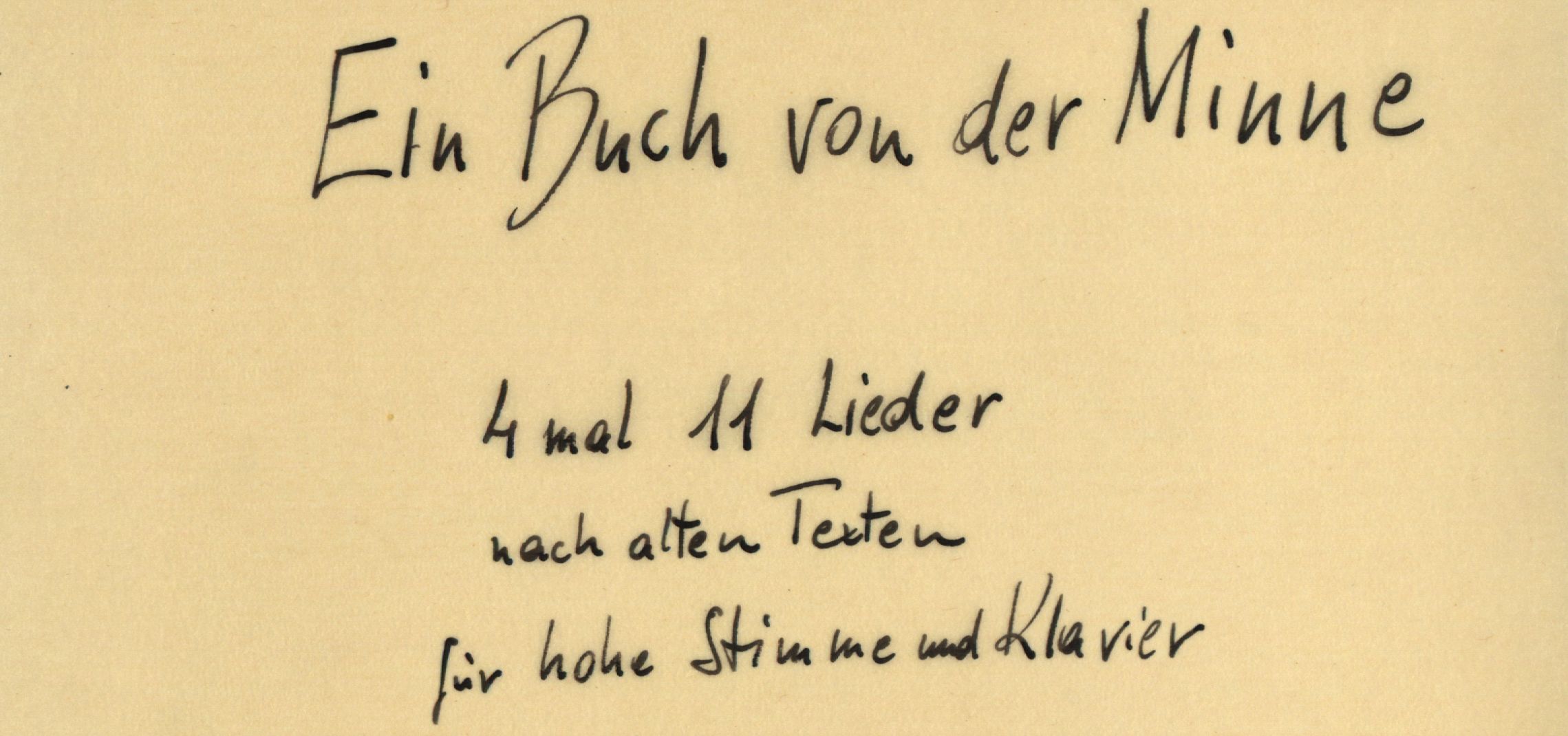
Cerha, Ein Buch von der Minne, handwritten score, title page, ca. 1966, AdZ, 00000014/102
“4 x 11 Songs” indicates that the Minnebüchlein is not just one big cycle, but actually four cycles that join together. The balanced proportions are reminiscent of Schubert’s Winterreise (setting of Wilhelm Müller), which features two symmetrical halves of 12 songs each. Similar divisions are familiar not only from poetry and song cycles, but are also seen in large, novel-like forms, such as several of Mahler’s symphonies combining several movements. Both here and there, it is a question of narrative structuring: a division into chapters.
Something else is characteristic in connection with the internal ordering of Cerha’s Buch von der Minne: It grew into a musical whole over the course of a considerable period of time. In the 1960s, Exercises took the concept of networking such processes in a different direction. There, too, various individual movements emerged over time, finally coming together to form an organism almost by themselves. The Minnebüchlein anticipates this style of origination; the formation of its cycle was not completed until 1966. A number of notes in Cerha’s sketches show that the division into four parts took place over time. The already finished songs were arranged in different orders several times. In earlier stages, the four sub-cycles that emerged later cannot yet be discerned. There are also several significant differences in how the songs are combined. At the beginning of the cycle, several of the early handwritten listings continue to include the song “Du bist mein, ich bin dein” (still abbreviated as “Ich bin dein” in the manuscripts), a title which contains one of the most renowned medieval verses of all, prototypical of courtly love poetry and thus well suited as an opening number. In the final version, however, the piece wanders on to become the seventh, bracketed by one hushed and one lively number. Instead, perhaps motivated by a desire for a catchy introduction, Cerha then places the very characteristic song “Ich schlaf, ich wach, ich geh ich steh” at the beginning. Exchanging and repositioning can also be seen elsewhere. The gentle, lyrical song “Es ist ein Schnee gefallen” concludes the first section in many early arrangements—wandering from number 7, to 9, or to 10, depending on the length of the sections, which is likewise always changing. It is not until much later, within the final version of the cycle, that it migrates significantly towards the end. In the final version, it is found in 40th position, one of the last numbers of the work. The reasons for this are probably dramaturgical in nature: It is possible that Cerha wanted to strengthen the connection between the first and the final part. After all, the song’s rigid and memorable monothematic nature ties in with the supreme creative principles of the circle of artists around Paul Kont at the time. In the final cycle, the song is surrounded by more recent pieces (Nos. 39 and 43) that explore new musical ideas. This combination increases contrast (and thus also internal tension).
Friedrich and Gertraud Cerha, manuscript pages showing different song arrangements for Buch von der Minne, undated, AdZ, 000S0014
The numerous song combinations are always different in their details, and are also an early indication that the final cycle does not follow any stringent rules. An aesthetic maxim Cerha later formulated could also apply to the Minnebüchlein: “Different things, loosely joined to form a unity, rich diversity, merging into one.”Schriften: ein Netzwerk, Vienna 2001, p. 239. The concert history alone indicates a certain autonomy among the various songs. The first performance, at the Vienna Women’s Club in 1951, included a selection of different songs. Later concerts took a similar approach, although there was always a different selection—usually performed with two singers (soprano and tenor), as Cerha recommended for cyclical performances.Cerha, Ein Buch von der Minne, handwritten score, AdZ, 00000014/106
In light of this, it is hardly surprising that the “4 x 11” combination of songs does not follow a particular narration—nor is there a connecting lyrical “I” to create narrative cohesion. However, a comparison of the four sub-cycles does reveal certain tendencies, also with regard to the selected poetry. It is striking, for example, that the first part is made up almost exclusively of poems of anonymous authorship (with the exception of No. 11). Usually only a few verses long, the songs keep a timeless, almost archaic tone. After this first cycle, things become more concrete. For the second part, Cerha focuses on poems by Kürenberger, mixing them with other love poetry. The poetry becomes increasingly narrative, playing more clearly with medieval motifs (falconry or knighthood, for example). This tendency continues in the third section, which also has the greatest diversity of authors. The scenes are luxurious: A riverside meadow becomes the scene of erotic desire (No. 27), lovers unite in a nocturnal scene only to be separated at dawn (No. 28), a young man courts “the king’s daughter” (No. 32). The fourth and final section, in contrast, partially returns to the timelessness of the opening part. This is achieved through the transcendent, impersonal verses of Mechthild von Magdeburg (Nos. 43 and 44), along with the spiritual poem “O Röslein rot”, which made its way not only into Clemens Brentano’s folk song collection Des Knaben Wunderhorn under the name “Urlicht” in the nineteenth century, but also into Gustav Mahler’s Second Symphony.
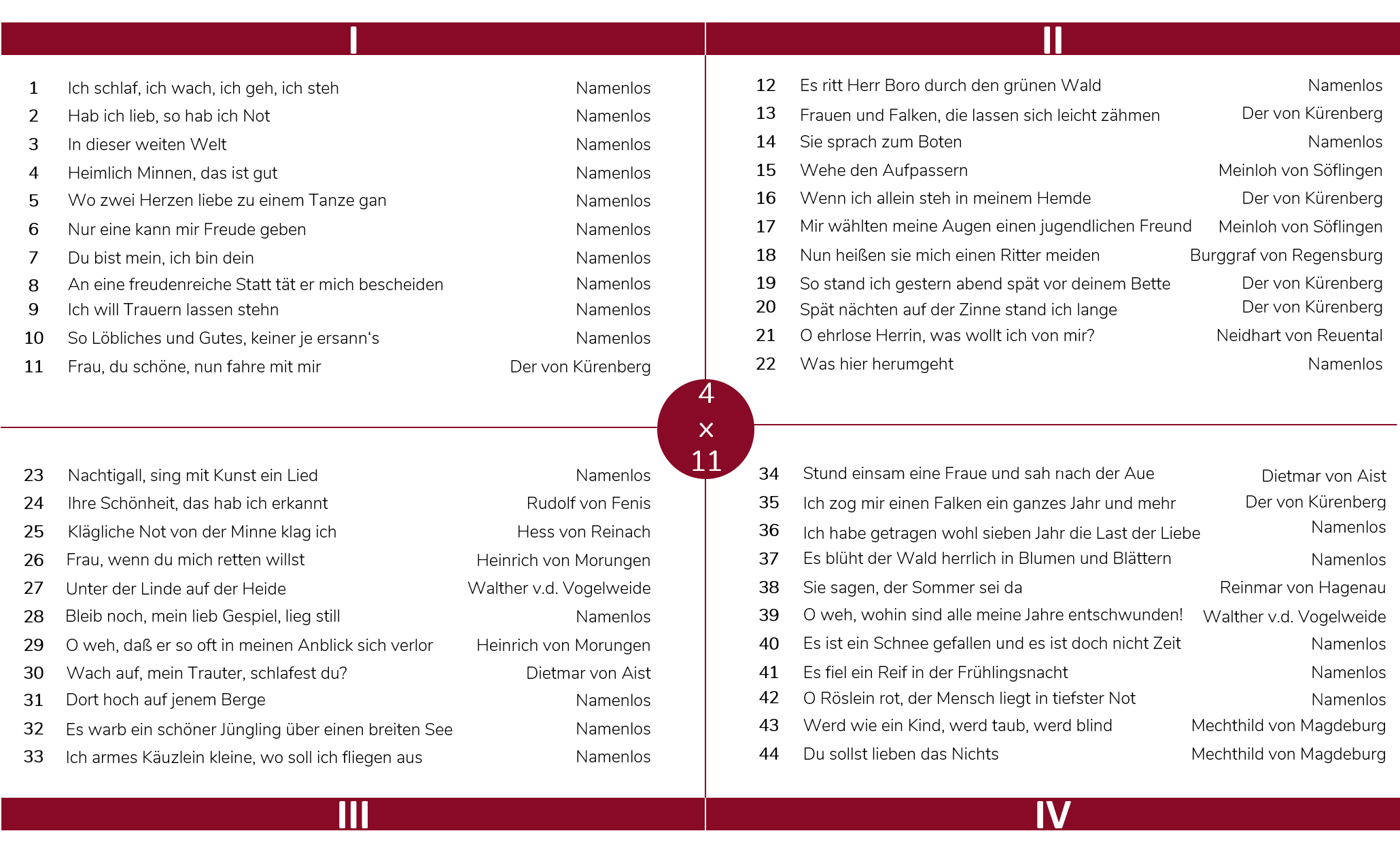
Despite the large number of songs, 44 in all, an easy musical unity emerges, not only when comparing the pieces, but also within them individually. The Austrian minimalist movement of the early post-war years, which Cerha identified with, celebrated stasis as a musical quality. A song should live from a single idea: a sole motif repeated on different scales, one character maintained from beginning to end. Cerha explains the following about the songs from the Minnebüchlein:
The radical restriction to a single character contradicts the Wolf-Straussian technique of tracing and illustrating the lyrics, deliberately following older song forms. […] Larger sections or even an entire piece are set into motion, there is almost no thematic development, there are Melic poet figures in just a few variants, harmonic levels often shift, yet tension nonetheless unfolds more often in my songs than was the case with the works of other composers in the scene. At the same time, I was also fascinated by lack of development, and anything related to a Far Eastern way of thinking in “changes”, something proven by my lost setting of the I-Ching (1952), and by my attendance to a composition class taught by Josef Matthias Hauer (1953) and my study of his Zwöftonspiele
Friedrich Cerha
Schriften: ein Netzwerk, Vienna 2001, p. 219
In their simplicity, Cerha’s songs of love set themselves apart from the many types of composition that dominated European art music for centuries: dramatic forms, dual contrasts, the development and further processing of motifs. By foregoing all this, Cerha also drew a musical link to an era far in the past: Real courtly love poetry and poetry performed by troubadours concentrated on natural singing, closely aligned with speech patterns, and a simple accompaniment by, for example, a lute or harp.
4 x 1 songs from Buch der Minne
Playing 44 songs at once is impractical, so it goes almost without saying that the entire cycle is not often heard in concert. Therefore, a kind of “sub-cycle” has emerged over time, based on a selection Cerha made for the Doblinger publishing house. He compiled 14 songs from Parts 1, 3, and 4 (half of them from the first part). For concerts, these songs are usually recombined yet again, making a “selection of the selection”. A handful of songs (1–3, 5–7, 11, 28, and 41) have emerged as a kind of core that characterizes many performances. Four of these “core songs” will now provide us with a deeper insight into Cerha’s poetry settings.
[Interpreters: Georg Klimbacher (baritone) and Andreas Fröschl (piano)]




